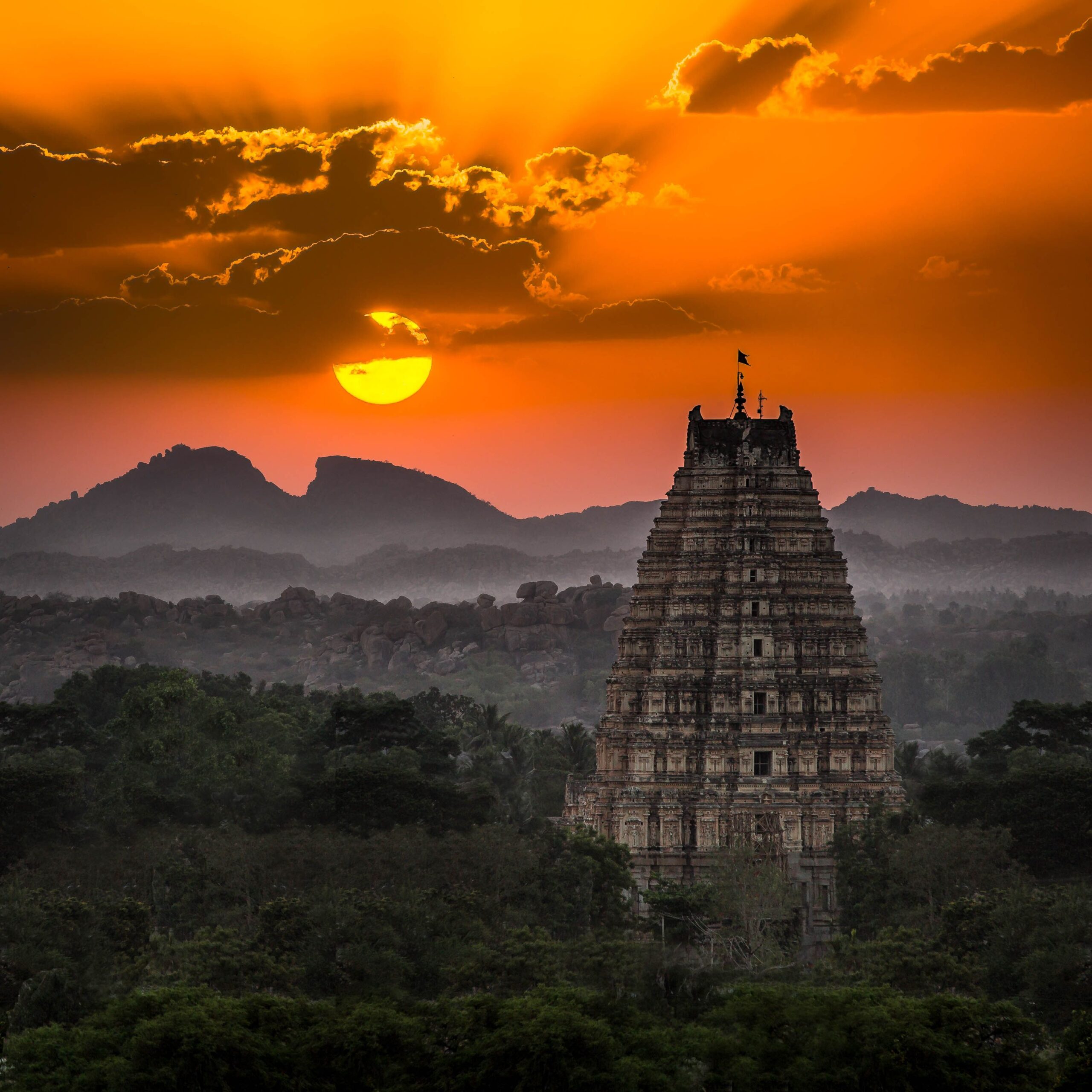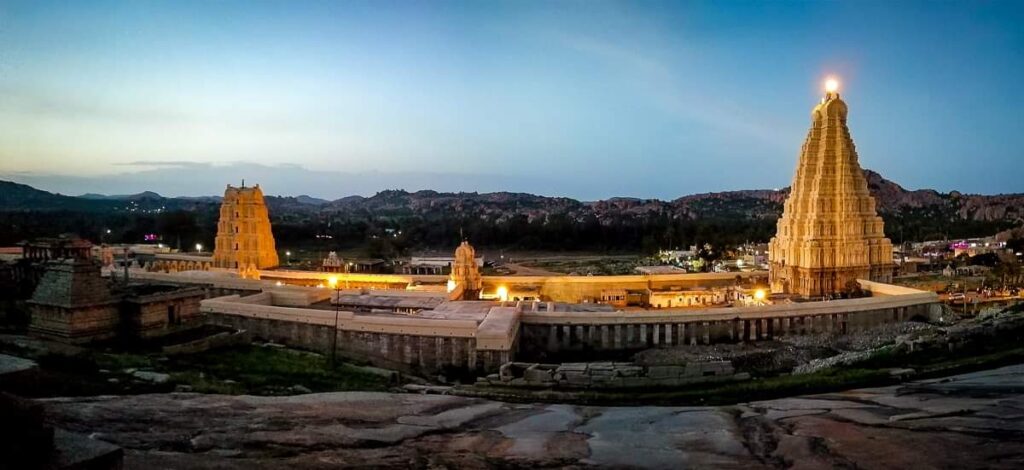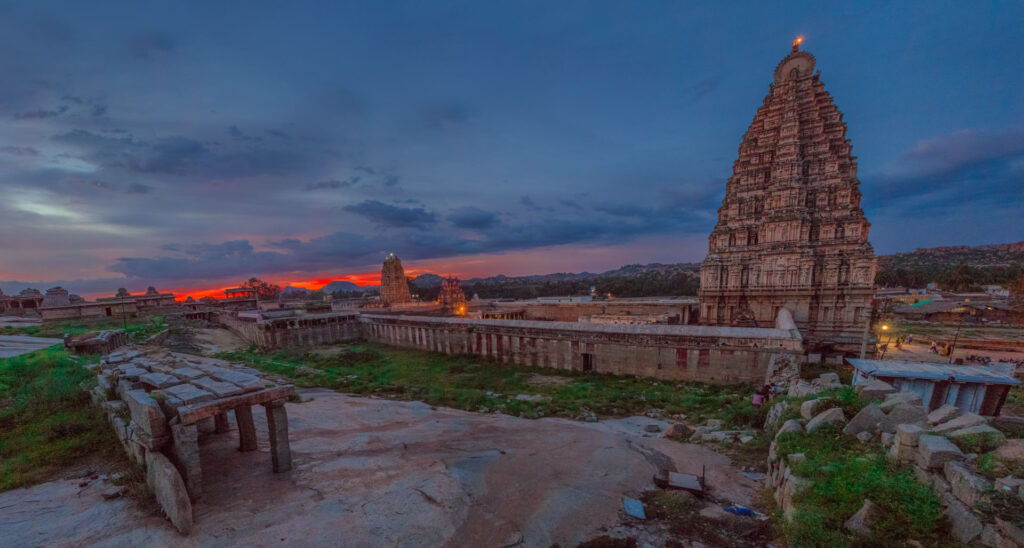
Virupaksha Temple is the oldest and most important temple in the Hampi town of Vijayanagara district in Karnataka (India). It is the only temple of its kind in Hampi where the worship is continuing. Virupaksha Temple is also famed for the pinhole camera effect in one of its walls.
Virupaksha Temple sits on the southern bank of the sacred Tungabhadra River where it appears to be a precious gem glorifying the river. The temple is dedicated to Lord Shiva, who is known here as Virupaksha. Pampa Devi, the presiding deity of the sacred Tungabhadra river is Lord Virupaksha’s consort.
Who would not know Hampi in name at least? A city whose fame reverberates throughout the world! A city carved entirely in stone where every stone and corner narrate a story! Hampi is historically connected to the lilas of the Ramayana era and thus, falls on the Ramayana trail.
As Hampi is a UNESCO World Heritage Site, the temple shares a slice of that fame too.
History of Virupaksha Temple
The Virupaksha Temple has a glorious past spanning many centuries. Virupaksha Temple was originally a small shrine dedicated to Virupaksha Swamy, which grew to huge proportions during the glorious rule of the Vijayanagar Kings. It was built originally by King Pulakesi II of Badami Chalukya dynasty and later expanded by successive kings. The temple reached its zenith during the rule of the Hoysalas and Vijayanagar Empire.
The inscriptions on the temple referring to Virupaksha Swamy date back to the ninth and tenth centuries. You would not be able to imagine the way in which Virupaksha Swamy was worshipped or how his festivals were celebrated. The stones, hills, hillocks and Tungabhadra river are all witness to the history of the Virupaksha Temple whether bad time or good time.
Only if they would agree to tell us the wonder that was Virupaksha Temple. They all talk but perhaps we humans could understand only little.
It is said that Pampa Devi, the daughter of Lord Brahma performed hard penances to achieve Lord Shiva as her husband. Finally, she achieved the favour of Lord Shiva who married her. Thus, Lord Shiva came to be known as Pampapathi.
As Pampa Devi meditated on the banks of the Tungabhadra river, it came to be called as Pampa Sarovara. The place came to be known as Pampa Kshetra or Pampapura.
Deities of Virupaksha Temple
Virupaksha Swamy is the main Deity of the Virupaksha Temple. There are deities of two four-armed guardians who stand and guard his shrine entrance. Nandideva sits opposite Virupaksha Swamy facing him. The deity of Nandideva here is unique as he has three heads unusually.
His consorts Pampa Devi and Bhuvaneshwari Devi reside in shrines to the north of the Virupaksha Swamy shrine.
Lord Ganesha resides in the southern region of the temple complex. At an underground chamber is the Shivalinga of Lord Pataleshwara. On an elevated platform, there are deities of the Navagrahas.
Architecture of Virupaksha Temple
Located in the erstwhile Vijayanagar empire, the Virupaksha Temple has been constructed using the Vijayanagar architectural style in brick and mortar. This architecture is a mix of the best elements from the Dravidian, Hoysala and Chalukyan architectural styles. Inscriptions dating back to the 10th century indicate that King Kalyana Chalukya of the Chalukya Dynasty granted land for the construction of the Virupaksha Temple. Initially a small temple, it was expanded over the course of the centuries with sub-shrines, mandapams, gopurams, dhwajastambham and a large temple kitchen.
The nine-tiered east facing gopuram is the entrance to the temple’s first courtyard. There are horn like projections on the top while the lower two tiers have many sculpting. In this courtyard is a 100-pillar mandapam at the far-left corner. At the far-right corner is the Kalyana mandapam, admin offices, ticket counter and an old well.
The kitchen complex projects out of the compound overlapping the two courts at the south wall. The temple kitchen is accessible via the 100-pillar mandapam. The temple kitchen gets its water supply through a water channel system connected to the Tungabhadra river.
A three-tiered gopuram facing the western direction is called as Krishnadevaraya Gopuram.
In the open area around the main temple are pillared cloisters with spaces at the north, south and east edges hosting a few sub-shrines. A row of decorated pillars lines the facing side of the cloister. These pillars are thin at the top with many carvings. There are elephant balustrades at the middle of the row which gives access to the top of the cloister platform.
The shrine of Pataleshwara is located underground. It is accessible through a rectangular opening at the western end of the southern cloister. This opening is guarded by Nandi. A huge stone urn with decorations can be seen besides the Nandi sculpting. Further ahead is the shrine of the Navagrahas.
A central pillared hall constructed by King Krishnadevaraya in 1510 CE and called Ranga Mandapam is a treat for your eye. Two lion-like creatures (Yali) guard the entrance to the Ranga Mandapam which is an elevated platform. Having 38 pillars and five aisles, this mandapam is used for performing marriage ceremonies and other temple rituals. The pillars here too are really very special with Yalis (lion-like creatures) standing on aquatic creatures driven by warriors.
A mural-painting panel occupies the central portion of the mandapam ceiling with themes from the Vedic scriptures. Beautiful sculpting adorns the roof of the mandapam.
Towards the Virupaksha Garbhagriha
Next comes a small inner hall which is guarded by two guardian deities. An open lotus motif decorates the ceiling of this inner hall. Further west is the east-facing Garbhagriha of Virupaksha Swamy. Access to the Garbhagriha and exit is through two narrow porches on either side of the inner hall.
There are shrines dedicated to Pampa Devi, the consort of Virupaksha Swamy and other deities around the Garbhagriha such as Bhuvaneshwari Devi. The rear exit of the temple is through a flight of steps behind the Garbhagriha. Nearby is a shrine dedicated to Sri Vidyaranya, the Jagadguru of the Shringeri Sharadha Peetam from 1374 to 1380 CE, who helped found the Vijayanagar Empire.
The Kangiri Gopuram near the Garbhagriha leads to the temple pond called as Manmatha Pushkarini or Manmukha Teertha flanked by a few shrines on either side. This path also leads to the Tungabhadra river.
Towards the south along the outer wall, you will reach a small pond surrounded by pillars. There are shrines present here without any worship happening.
Festivals of Virupaksha Temple
The Virupaksha Temple sees a few festivals celebrated within its complex and outside the boundaries of the temple too. This includes the Maha Shivaratri, Phalapuja, Virupaksha Rathotsava and Diwali.
Maha Shivaratri: A very important festival celebrated in the month of February/March especially being a temple dedicated to Lord Shiva.
Phalapuja: This festival celebrates the divine marriage of Virupaksha Swamy and Pampa Devi in the month of December.
Virupaksha Rathotsava: Virupaksha Swamy and his consort Pampa Devi are given a ride in a wooden ratha (chariot) through the streets of Hampi in the month of March/April.
Diwali: Diwali puja is done at the temple in the evening during Diwali festival in the month of October. The temple elephant ‘Lakshmi’ participates in a local procession on Diwali.
Apart from these festivals, the temple takes part in the grand Hampi festival held every year as a cultural event.
Temple Timings of Virupaksha Temple
The Virupaksha Temple is open for darshan at the following time:
Morning: 6 AM to 1 PM
Evening: 5 PM to 9 PM
During festive occasions, there would be variation in the temple timings.
Best Time to Visit Virupaksha Temple
The months of October to March sees a pleasant climate to visit the Virupaksha Temple. Moreover, many important festivals happen during this period.
But you could always travel anytime of the year. Many devotees and tourists could be found at the temple round the year.
How to Reach Virupaksha Temple
To get a fulfilling experience of Virupaksha Temple, join Hampi Tour with Tirtha Yatra. As Virupaksha Temple is located in Hampi, there are no hassles with transportation. Being a UNESCO World Heritage Site, there are special packages to reach Hampi.
You may find the following options helpful –
By Road: Hampi is well connected via state and national highways to cities and towns in Karnataka and neighbouring states. KSRTC operates bus services between Hampi and these cities/towns. There are private intra-state buses and inter-state services from Goa, Maharashtra, Andhra Pradesh, etc. You can avail cab services from nearby cities too.
By Rail: Hospet Junction (HPT) 13 km away is the nearest railway station which connects Hampi pan-India. Hubbali Junction (UBL) 166 km away is the next nearest station. You can alight here and use the road route to reach Hampi. If you are alighting at Hubbali Junction, you may also catch a train from the same station to Hospet Junction.
By Air: Hubballi Airport (HBX) 170 km away is the nearest domestic airport. The Kempegowda International Airport (BLR) at Bengaluru is the nearest international airport 360 km away. You can fly in here and use the road or rail route to reach Hampi.
2












2 Comments On Virupaksha Temple, Hampi
Balaji BG
Everything said & done the pinhole camera image of the front Gopuram is not dealt in the description and place where it can be seen also not written
Thank u for the detail, if god permit ,i will
Visit all the temples. God bless you for your service.